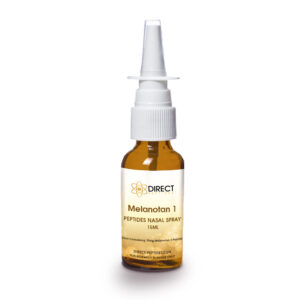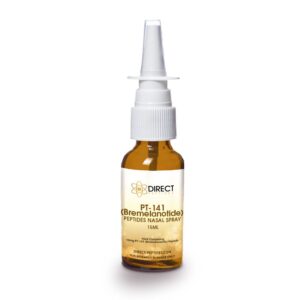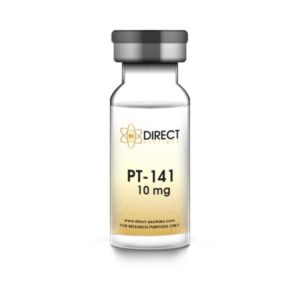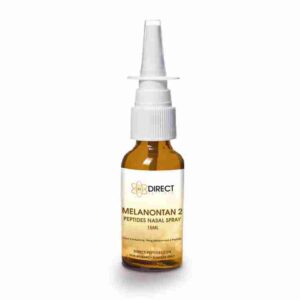Please be aware of our revised hours during the holiday season. We will operate on a half-day schedule on December 24th and 31st and will be CLOSED from December 25th to 28th, with limited customer service available. We will fully REOPEN on December 29th and again on January 2nd.
For researchers studying pigmentation and hormonal pathways, understanding Melanotan 1 vs Melanotan 2 is essential. The main difference is in receptor selectivity. Melanotan 2 shows greater potency at several melanocortin receptors compared to Melanotan 1, which mainly acts on MC1R. Both are synthetic peptides that mimic the body’s natural process of melanin production, controlling skin pigmentation and how the skin responds to UV exposure and UV light. Their unique amino acid structures create different results in experimental research.
Melanotan 1 mainly targets MC1R receptors linked to pigmentation. This makes it useful for studies focused on tanning, sun damage protection, and risk of sunburn. Melanotan 2 interacts with several melanocortin receptors, including MC1R, MC3R, MC4R, and MC5R. It can affect sympathetic nervous system activity, which influences blood pressure, sexual arousal, and energy balance. Its action on MC5R also affects sebaceous gland activity and lipid metabolism. This adds value in dermatological and metabolic research.
This guide compares both peptides side by side, looking at their structure, receptor roles, potential benefits, common side effects, and how each may support specific study goals. Understanding these aspects helps researchers select the right analog for their experimental needs.
Explore Melanotan 1 from Direct Peptides Greece, a synthetic analog studied for its role in stimulating melanin production and supporting UV protection research.
The table below shows the main characteristics of both peptides and where each fits best in laboratory studies.
| Feature | Melanotan 1 (Afamelanotide) | Melanotan 2 |
|---|---|---|
| Structure | Linear peptide, stable analog of α-MSH | Cyclic peptide, modified for higher potency |
| Primary Receptor Target | MC1R (melanocortin 1 receptor) | MC1R, MC3R, MC4R, MC5R |
| Main Research Focus | Pigmentation, tanning, and UV protection studies | Pigmentation, energy balance, appetite, and sexual stimulation research |
| Observed Potency | Moderate and receptor-specific | Higher potency and multi-receptor activation |
| Common Side Effects (in studies) | Mild redness, fatigue | Nausea, flushing, transient appetite loss |
| Stability in Lab Use | High, longer half-life | Slightly lower, faster breakdown rate |
| Best Suited For Research In | Photobiology, dermatology, pigment response | Endocrine, metabolic, and behavioral pathways |
Both Melanotan 1 and Melanotan 2 are synthetic peptides made of amino acid chains modeled after α-MSH. In research environments, Melanotan nasal sprays are often examined to study melanin production, skin pigmentation, and hormonal effects. Observations may include changes in blood pressure and sexual stimulation, depending on receptor activation. These studies are conducted only for research purposes in approved conditions.
These differences help researchers decide which peptide fits their study goals. The next section explains why their structural and receptor differences exist and what they show about peptide function.
Discover Melanotan 2 from Direct Peptides Greece, a potent research peptide examined for its influence on pigmentation, appetite regulation, and hormonal response pathways.
 Both Melanotan 1 and Melanotan 2 come from research on alpha-melanocyte–stimulating hormone (α-MSH). This natural peptide activates melanocortin receptors involved in pigmentation, metabolism, and hormonal signaling. Scientists wanted to design stable analogs that could mimic melanin-related pathways and show how receptor selectivity affects biological responses.
Both Melanotan 1 and Melanotan 2 come from research on alpha-melanocyte–stimulating hormone (α-MSH). This natural peptide activates melanocortin receptors involved in pigmentation, metabolism, and hormonal signaling. Scientists wanted to design stable analogs that could mimic melanin-related pathways and show how receptor selectivity affects biological responses.
Melanotan 1 was the first analog. It has a linear structure that provides stability and precision at the MC1R receptor, which controls melanin production, skin pigmentation, and photoprotection. Melanotan 2 came later. It has a cyclic structure that increases potency and allows interaction with multiple receptors, including MC1R, MC3R, MC4R, and MC5R.
This structural change explains why Melanotan 2 shows broader activity in metabolic and neuroendocrine research. Studies include topics such as sexual arousal and spontaneous erections, while Melanotan 1 remains useful for focused pigmentation and UV light research. Understanding these receptor roles helps define how each peptide contributes to different research fields.
Scientific studies have shown several important benefits linked to Melanotan peptides. Melanotan 1 helps support melanin production, allowing researchers to study natural defense mechanisms against UV exposure, oxidative stress, and sun damage. Its receptor-specific action and high stability make it reliable for long-term pigmentation and photoprotection research.
Melanotan 2, with its broader receptor activity, shows additional effects in studies about appetite regulation, energy balance, and sexual stimulation. Its impact across several melanocortin receptors gives scientists valuable insight into metabolic and neuroendocrine pathways. These results show how Melanotan peptides can help explore pigmentation, hormonal signaling, and receptor function more deeply.
With these benefits also come biological reactions, which researchers monitor to understand receptor response, sensitivity, and safe experimental limits.
In laboratory models, researchers have seen several dose-related effects when analyzing Melanotan peptides. These reactions help explain the effects of Melanotan and how receptor activation influences biological processes.
Melanotan 1 usually causes few side effects because it mainly acts on MC1R. Research notes temporary redness, mild fatigue, or light headaches, which are often short-lived and self-resolving.
Melanotan 2 affects more receptors and can show a wider range of reactions. Studies note nausea, flushing, appetite suppression, and increased heart rate in some test models. Knowing these reactions helps scientists control dosage, duration, and receptor mapping in their experiments.
These findings also explain the regulatory status of both compounds. Melanotan 1 and Melanotan 2 are only for research purposes and are not approved for human use in the United States or other regions.
No single peptide is better for every study. Each has strengths that depend on the research goal. Melanotan 1 offers precise, receptor-specific activity, which makes it ideal for pigmentation and UV-response studies that need consistent and clear results.
Melanotan 2 stands out for its broader receptor activity and ability to produce data across metabolic, neuroendocrine, and behavioral pathways. Its multiple receptor targets make it suitable for complex biological modeling and receptor comparison studies.
The best peptide depends on whether the study values specificity or range. Melanotan 1 gives focused, stable pigmentation data, while Melanotan 2 provides wider biological insights. Both add important information to ongoing melanocortin receptor and synthetic peptide research.
At Direct Peptides, we help support this research by supplying high-quality, research-grade peptides tested for purity and consistency. Our catalog includes both Melanotan 1 and Melanotan 2, helping researchers worldwide explore melanocortin biology with accuracy and confidence.
References:
1 Dorr RT, Ertl G, Levine N, Brooks C, Bangert JL, Powell MB, Humphrey S, Alberts DS. Effects of a superpotent melanotropic peptide in combination with solar UV radiation on tanning of the skin in human volunteers. Arch Dermatol. 2004 Jul;140(7):827-35.
2 Torres AE, Lyons AB, Hamzavi IH, Lim HW. Role of phototherapy in the era of biologics. J Am Acad Dermatol. 2021 Feb;84(2):479-485.
3 Wessells H, Fuciarelli K, Hansen J, Hadley ME, Hruby VJ, Dorr R, Levine N. Synthetic melanotropic peptide initiates erections in men with psychogenic erectile dysfunction: double-blind, placebo controlled crossover study. J Urol. 1998 Aug;160(2):389-93.
4 Bellei B, Papaccio F, Picardo M. Regenerative Medicine-Based Treatment for Vitiligo: An Overview. Biomedicines. 2022 Oct 28;10(11):2744.
5 Wessells H, Levine N, Hadley ME, Dorr R, Hruby V. Melanocortin receptor agonists, penile erection, and sexual motivation: human studies with Melanotan II. Int J Impot Res. 2000 Oct;12 Suppl 4:S74-9.
Nasal Sprays are available Online from Direct Peptides Greece. Peptide Nasals offer a convenient alternative to researching peptides without the use of injections.
Melanotan 1 is usually preferred for pigmentation-focused research because it selectively activates MC1R and provides predictable, stable results in photobiology and dermatology models.
Melanotan 2 activates additional receptors beyond MC1R, resulting in broader systemic responses, such as nausea, appetite suppression, or flushing seen in research environments.
Researchers needing highly targeted pigmentation data often choose Melanotan 1, while those studying metabolic, behavioral, or neuroendocrine pathways benefit from Melanotan 2’s wider receptor engagement.
No. Both Melanotan 1 and Melanotan 2 are unapproved for human use in the U.S. and many other regions and are supplied strictly for laboratory research purposes.
Melanotan 1’s linear peptide design contributes to a longer half-life and higher stability compared to the cyclic structure of Melanotan 2.
Yes. Due to its activity at MC3R and MC4R, Melanotan 2 is frequently examined in research involving sexual stimulation, appetite regulation, and energy balance.
Nasal sprays allow researchers to study absorption, receptor activation patterns, and peptide effectiveness without injectable delivery, making them useful in specific experimental models.
Direct Peptides provides high-purity, research-grade versions of both peptides along with nasal spray formats, enabling consistent, controlled experimentation across pigmentation, metabolic, and hormonal studies.

PT-141 (Bremelanotide) Nasal Spray
£29.45 – £53.90Price range: £29.45 through £53.90 Select options This product has multiple variants. The options may be chosen on the product page
New Reduced Price
PT-141 Peptide Vial (Bremelanotide)
£21.45 – £30.43Price range: £21.45 through £30.43 Select options This product has multiple variants. The options may be chosen on the product page
Melanotan 1 Nasal Spray
£25.19 – £45.38Price range: £25.19 through £45.38 Select options This product has multiple variants. The options may be chosen on the product page
Melanotan 2 Nasal Spray
£25.19 – £81.68Price range: £25.19 through £81.68 Select options This product has multiple variants. The options may be chosen on the product pageALL CONTENT AND PRODUCT INFORMATION AVAILABLE ON THIS WEBSITE IS FOR EDUCATIONAL PURPOSES ONLY.
DISCLAIMER: These products are intended solely as a research chemical only. This classification allows for their use only for research development and laboratory studies. The information available on our Greece Direct Peptides website: https://direct-peptides.com is provided for educational purposes only. These products are not for human or animal use or consumption in any manner. Handling of these products should be limited to suitably qualified professionals. They are not to be classified as a drug, food, cosmetic, or medicinal product and must not be mislabelled or used as such.